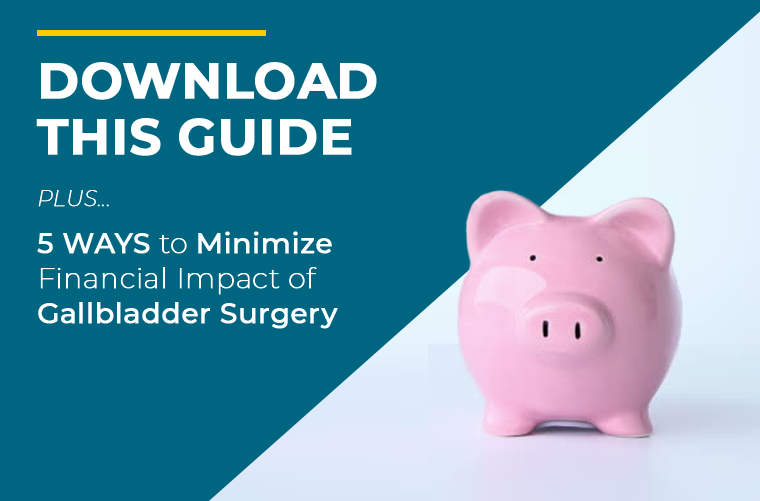Want to read this guide later?
5 Signs You May Need Gallbladder Surgery
What are the symptoms of a gallbladder attack?
You probably haven’t thought much about this tiny organ – unless you have experienced the extreme pain of a gallbladder attack, otherwise known as inflamed gallstones. But the gallbladder can be a source of big problems.
This article will help you understand the signs of gallbladder pain and when you should seek a surgeon’s advice.
What Is the Gallbladder? What are Gallstones?
The gallbladder (gall bladder) is a sac that sits in the upper right part of your abdomen (belly), which collects and stores bile produced by the liver. Think of the gallbladder like a liquid soap dispenser and bile is the soap that helps the digestive tract absorb fatty foods.
With normal function, the gallbladder does this painlessly and automatically. All liquid soap dispensers form soap scum with dehydration. Essentially, gallstones are dehydrated soap scum largely composed of cholesterol. They are originally soft and mushy, like Play-Doh, but harden with time.
Signs Your Gallbladder May Need To Be Removed
Most people with gallstones don’t know that they have them – but in some cases, a gallstone may cause the gallbladder to become inflamed, causing pain, infection, or other serious complications.
You may need gallbladder surgery if you have pain or other symptoms caused by gallstones.
Common symptoms of gallbladder problems include:
- Abdominal Pain. Sudden but steady pain in the upper right side or middle of your belly which can be dull, sharp or cramping.
- Nausea. Queasiness or vomiting are common symptoms.
- Jaundice. Yellowing of the skin and the whites of the eyes.
- Indigestion. Gastrointestinal disturbances like bloating, heartburn, and gas.
- Fever. An elevated temp can be a sign of gallbladder infection.
If your gallbladder is causing severe problems, your doctor will likely recommend surgery to remove it. The good news is that you can live without it.
Atypical Gallbladder Problems – Can Surgery Help?
What are atypical reasons that a gallbladder may need to be removed? Expand each condition to learn more.
In a recent article by Dr. Wright published in the American Journal of Surgery (2019), Wright looked at over 600 gallbladder surgeries performed at Meridian Surgery Center and found that a total of 182 patients (over 30%) had their gallbladders removed for atypical reasons. In the patients with biliary dyskinesia, 84% of patients had symptom resolution. 82% of patients with hyperdynamic gallbladders responded, 80% with polyps responded, and 57% of those with biliary colic and negative workup.
How Is the Gallbladder Removed?
Laparoscopic cholecystectomy (sometimes called keyhole gallbladder removal due to the small incision and use of a tiny camera during the procedure) is the most common approach for gallbladder surgery and what we perform here at Meridian Surgery Center.
The procedure is fairly simple: Several small incisions are made in the patient’s abdomen, the gallbladder is separated, sutures applied, and the gallbladder removed. In pre-op appointments, our surgeons take all the time needed for you to understand the details of the procedure and recovery expectations.
How Long is Gallbladder Surgery Recovery?
Laparoscopic procedures are less invasive, outpatient surgeries performed under general anesthesia, which means you’ll be asleep and pain-free during the operation and home within the day.
The average recovery time to return to normal work and activities is usually 1-2 weeks.
What Are the Risks of Gallbladder Removal?
Gallbladder removal surgery is considered a standard, safe procedure. Complications of laparoscopic surgery are rare. But, like any type of surgery, there are risks of complications, which can include bleeding, infection in the surgery area, blood clots, bile leakage, heart problems, hernias (when a small amount of your gut, or intestine, or other tissue bulges through the muscles that cover it). Your doctor will make sure that you completely understand the benefits and risks of surgery before your operation.
Learn more about Cascade Hernia & Surgical Solutions, specializing in gallbladder and gallbladder removal surgical options for Tacoma, Puyallup, and South Sound WA areas.
.
“I just had gallbladder surgery on Friday. He is very compassionate, his staff is very friendly as well. He called the next evening to see how I was doing. I highly recommend Dr. Wright”
Want to read this guide later?
Download this as a pdf and read it anytime! Plus, get more helpful info about Gallbladder surgical solutions.
Read about our privacy policy here.



